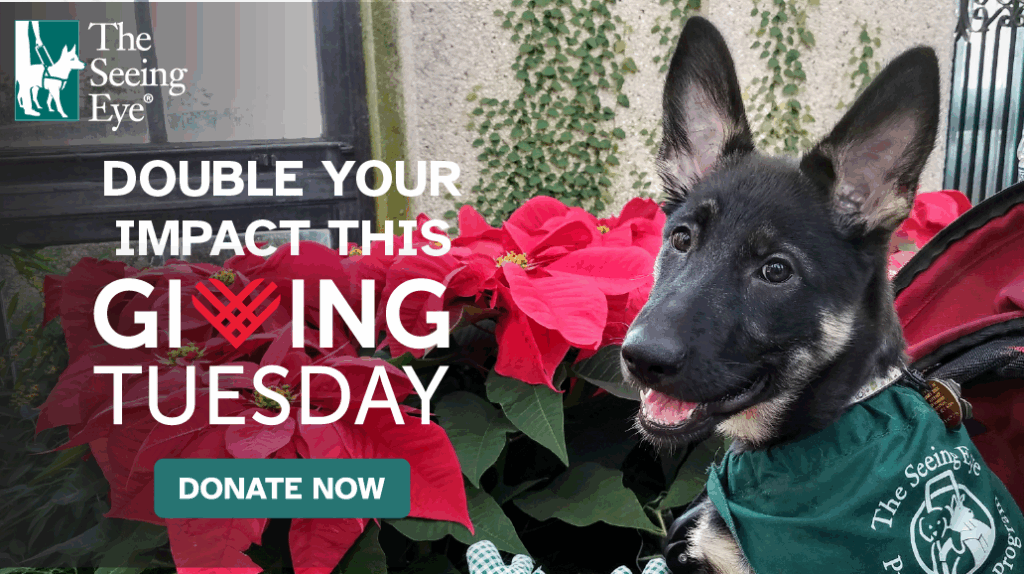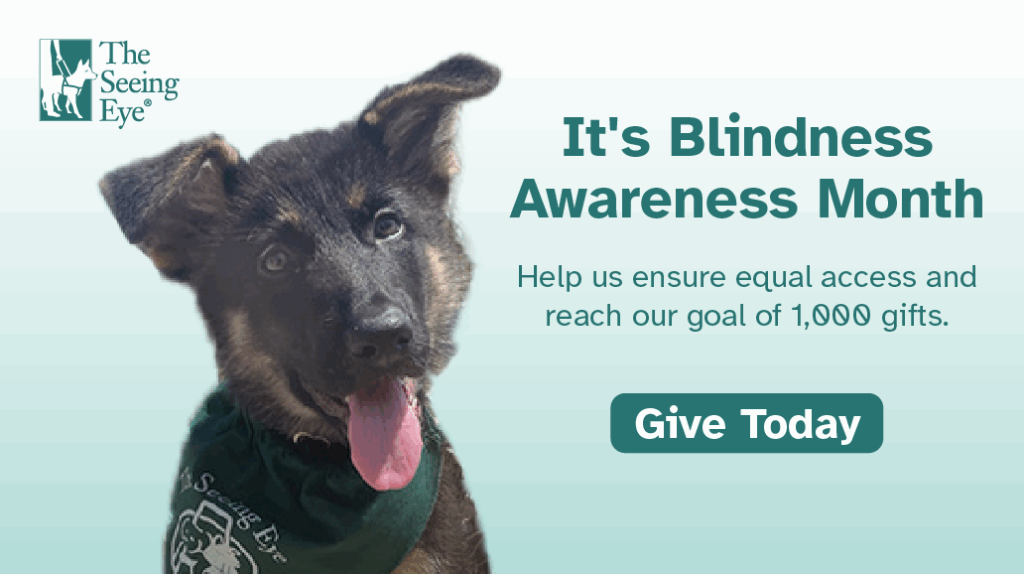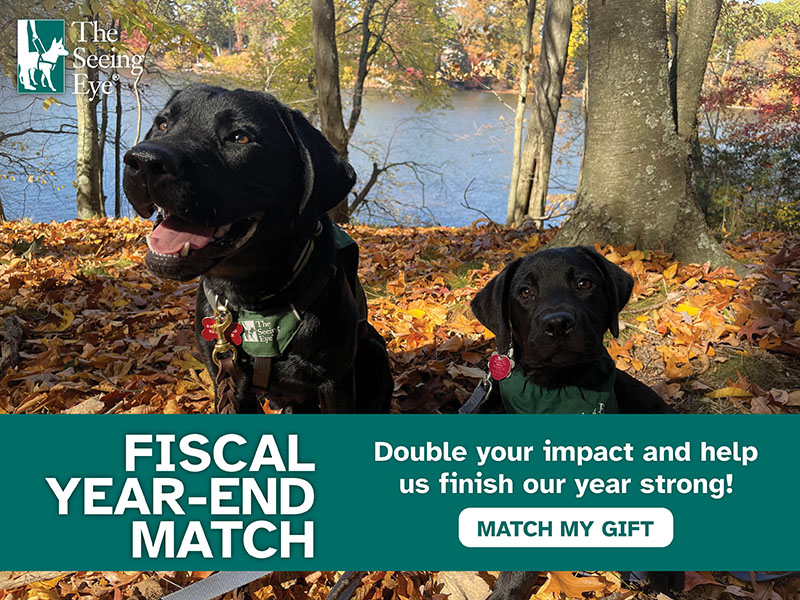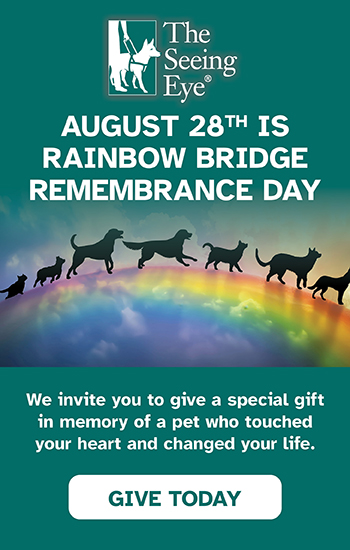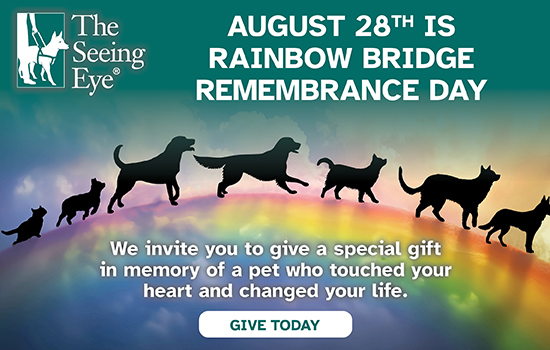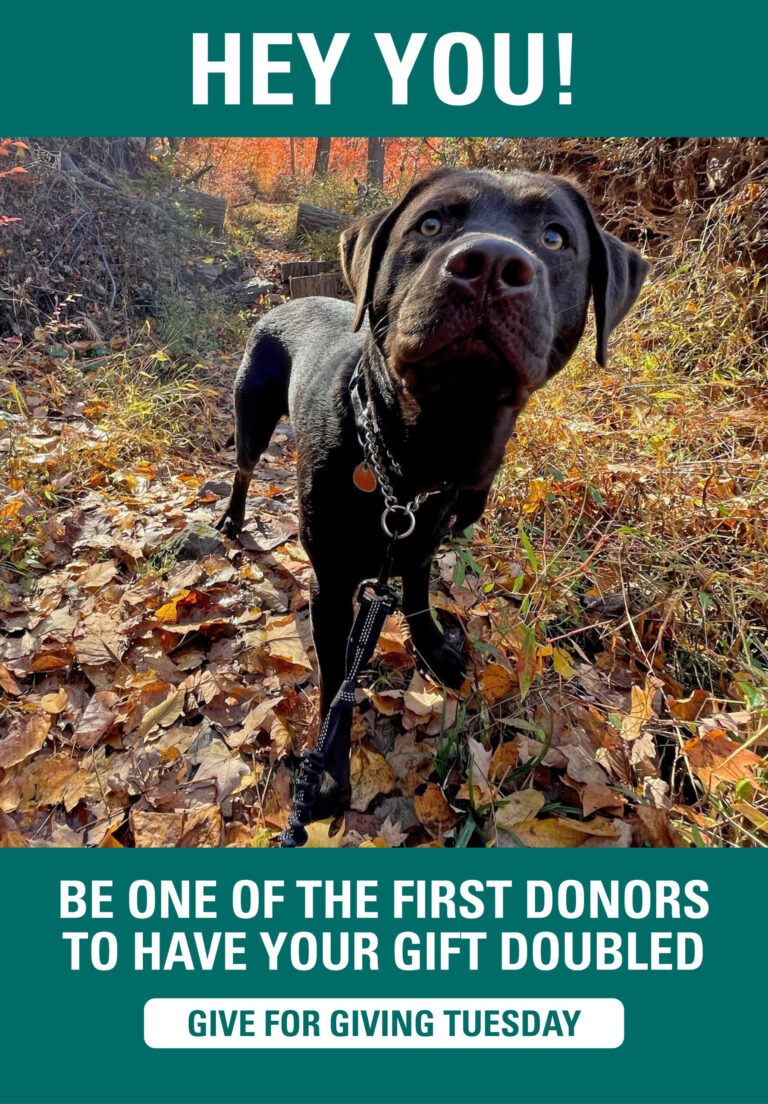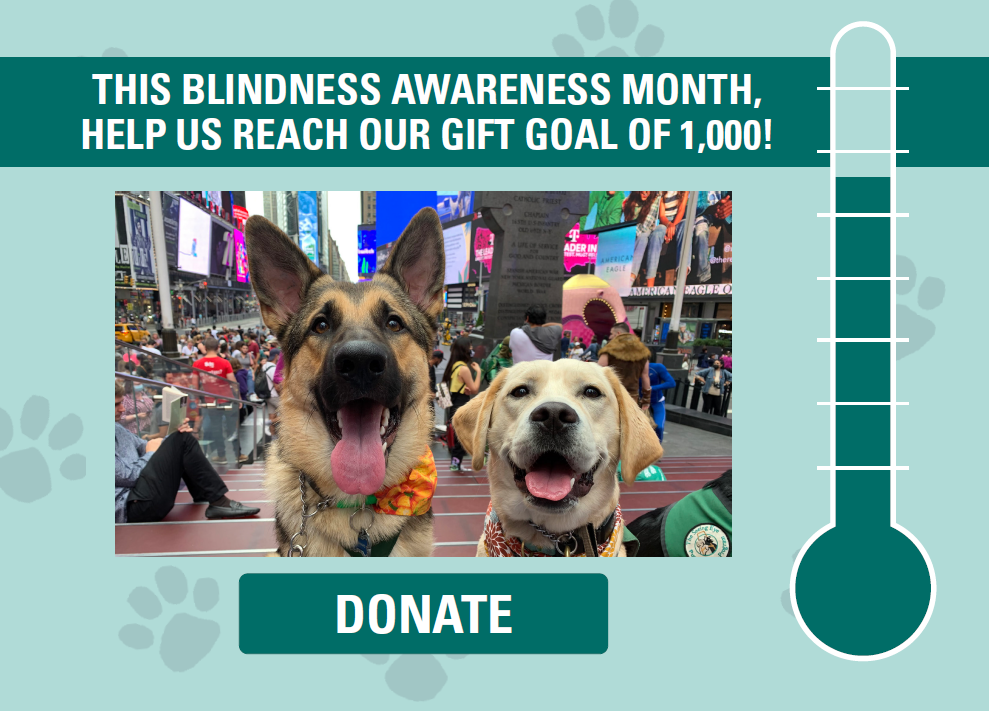Resources
FAQ
Frequently Asked Questions: General Information
Can I donate my dog or puppy to The Seeing Eye?
The Seeing Eye breeds its own German shepherds, Labrador retrievers, golden retrievers and Labrador/ golden retriever crosses. Learn more about The Seeing Eye breeding program.
Can I adopt a dog from The Seeing Eye?
Yes, although the waiting list can be quite lengthy. In certain situations, some of our dogs may not become Seeing Eye® dogs and are made available for adoption. To learn more about our adoption program, please visit our Dog Adoption page.
How much does a Seeing Eye dog cost?
Each student is asked to pay $150 for his or her first visit to The Seeing Eye and $50 for each subsequent visit. Those who served in the armed forces pay $1. This fee, unchanged since 1934, includes the cost of the dog and its initial equipment; the student’s instruction with the dog; room and board during the 18 to 25 days the student spends at the school; round-trip transportation from anywhere in the United States or Canada; and lifetime follow-up services. This payment, which may be made in installments, covers a fraction of the actual cost. To the student, however, it represents dignity and self-respect. No one has ever been denied a Seeing Eye dog for lack of funds.
Does the government provide funds for Seeing Eye dogs?
- The Seeing Eye receives no government funding. The school is supported by private donations, bequests, and gifts from foundations. Visit our “You Can Help” page to learn more about how you can make a difference.
Are people with guide dogs allowed in public places?
The Americans with Disabilities Act and laws in all 50 states and the provinces of Canada guarantee access to public places to blind people accompanied by Seeing Eye dogs. The dogs are trained to behave properly on public transportation, in restaurants, stores and any other place their handlers go. For more information, please visit our page about Rights & Legal Information.
What's the hardest part about having a guide dog?
The greatest difficulty guide dog handlers encounter is public interference. For anyone to take hold of the handler’s arm or the dog’s harness, or otherwise distract either the dog or its handler, is like grabbing the steering wheel of a car away from its driver. If you think a guide dog handler needs assistance, calmly ask if he or she would like help. The person can then accept or decline your offer. Download our tip sheet for more information about etiquette around guide dog teams.
Are all dogs that lead blind people Seeing Eye® dogs?
Only dogs trained by The Seeing Eye, Inc., of Morristown, N.J., are properly called Seeing Eye® The Seeing Eye is a registered trademark. The generic term for dogs trained by other schools is “guide dog.”
Frequently Asked Questions: Training
What are Seeing Eye dogs trained to do?
A Seeing Eye dog’s role is to guide their handler safely to a destination, while avoiding obstacles, hazards in the environment, and intelligently disobeying commands that would put the team in danger. Seeing Eye dogs assist their handler in tasks such as safely crossing a street, indicating the handle of a door, stopping for stairs and down curbs, and navigating a path in a busy or chaotic environment. Seeing Eye dogs are off duty when they are at home with their handler and get to relax and play like regular dogs.
How long does it take to train a dog?
- When a Seeing Eye puppy is about 8 weeks old, they are placed in the home of a volunteer puppy raiser who is responsible for teaching the puppy house manners, basic obedience, socialization, and providing a nurturing environment. When the puppy is about 1 year old, they return to The Seeing Eye and for a four-month course of training with a guide dog mobility instructor. When the dog passes this phase, they are matched with applicants and they train together, under the supervision of a guide dog mobility instructor. Learn more about Seeing Eye dog training.
How does a dog know when to cross the street?
- When approaching the curb, the handler is responsible for listening to the flow of traffic and giving his or her dog the “forward” command when the traffic is moving parallel to the crossing. The dog must watch for traffic and keep his or her handler safe from cars that may be turning right on red, running traffic lights or otherwise entering the crosswalk. This is where intelligent disobedience comes in – if it’s not safe to cross, the dog is trained to disobey the command until it is safe. Seeing Eye dogs are trained to display intelligent disobedience anytime following a command would put their handler in harm’s way. Seeing Eye dogs have been trained to safely guide their handlers through busy intersections since the first Seeing Eye dog was trained, and we continue to have the most rigorous traffic training program among guide dog schools.Learn more about Seeing Eye dog training.
How does a guide dog know where their handler wants to go?
Blind people generally know their own communities and can direct their dogs wherever they want to go. The basic commands are “forward,” “right,” and “left.” In a new location, blind men and women, like sighted people, ask for directions and communicate them to the dog by using the proper commands. Learn more about Seeing Eye dog training.
How long does a dog work?
The average working life for a Seeing Eye dog is 7 – 8 years. Many Seeing Eye dogs have worked to the ages of 10 or 11. Retired Seeing Eye dogs may be kept as pets, given to a friend or relative as a pet, or returned to The Seeing Eye and re-homed through our dog adoption program. Visit our training page to learn more about how Seeing Eye dogs are trained.
Can I train dogs for The Seeing Eye?
Our guide dog mobility instructors are full-time employees who have successfully completed three years of specialized on-the-job training. They relate well to dogs and people and are physically fit, since their jobs are physically demanding and involve working outdoors in all weather. Instructor position openings are rare and are often filled through promotion from within the organization. Visit our employment page to find out if we are currently hiring.
Frequently Asked Questions: Puppy Raising
How do I become a puppy raiser?
Volunteers begin the process by filling out a contact form. Learn more on the Raise a Puppy page.
What is puppy club, and do I have to join?
- Yes, when applying to raise a Seeing Eye puppy you must join your local puppy club. Meetings and outings organized by your club are there to help you develop your puppy into a confident dog while getting and providing support for other members.
I have never raised a dog before, is that ok?
Absolutely! Becoming a puppy raiser is a wonderful way to learn how to raise and train a puppy. You will have access to a support system that includes a staff member dedicated to assisting you and other raisers in your club. Puppy club meetings are designed to provide you with the tools to train your puppy, and the ability to learn from experienced puppy raisers. You will also receive a manual with information about training your puppy, puppy-proofing your home, guidelines for socialization, and other helpful information.
We have other pets in the house. Can we still raise a Seeing Eye puppy?
Yes! In fact, this is good exposure for the puppy. However, if you have another puppy in your house, that puppy should be a minimum of six months older than the Seeing Eye puppy. This is at the discretion of The Seeing Eye and dependent on each individual environment. Please let us know if your family pet is altered.
I’m not sure I can commit to raising a puppy full time, can I still volunteer?
You can volunteer as a puppy sitter to help other families when they need someone to watch their puppy while on vacation. You can also co-raise a puppy with another person in your club who may be in a similar situation.
Can children raise puppies?
Yes! The minimum age is 9 years old for a child to officially volunteer as their puppy’s primary raiser. There is no restriction on the age of children in the household, however, and families with children of all ages volunteer with the puppy raising program.
I'm an adult. Can I raise a puppy, and do I have to attend the meetings?
Adults are welcome to raise puppies as well! Many raisers start in retirement as a way to engage with other members of their community. Meeting and outing attendance is still required as it is a great learning experience for you and each individual puppy you raise.
How old will the puppy be when I get him or her?
The puppy is around 7 weeks old.
Do I need to go to the Seeing Eye to pick up my puppy?
When your Area Coordinator calls to tell you a puppy is available for your family they will set up a time to drop the puppy off at your home and go over directions and the puppy’s supplies with you.
What if the puppy needs veterinary care?
Families are responsible for scheduling veterinary care at the direction of The Seeing Eye’s vaccination schedule and your Area Coordinator. The Seeing Eye pays all medical expenses for their puppies.
Does The Seeing Eye provide food for the puppy?
Yes, The Seeing Eye provides food for the puppy.
What is the most important role of the puppy raiser?
Puppy raisers teach the puppies to be good and confident dog citizens. They teach the puppies house manners, obedience and show each puppy the world that they will encounter as a working Seeing Eye dog.
Can we take the puppies everywhere since they are going to be Seeing Eye dogs?
Only dogs trained to assist someone with a disability are granted access to public spaces under the Americans with Disabilities Act. However, many businesses throughout our puppy raising coverage area are accustomed to seeing our puppies and welcome them into their establishment. Because the puppies are not performing a service for our puppy raisers, we ask that you contact the manager before entering a store or other place of business to ask permission.
When can I start taking my puppy places?
Early exposure is essential, and a guideline will be given to you and reviewed with your Area Coordinator of where and when your pup can start venturing out in the big world.
Is it difficult to give the puppy back for training?
While it is hard to say goodbye to your friend, knowing that they are off to support someone’s independence makes saying goodbye worth it. Many families will get another puppy to raise to fill that void.
How old will my dog be when he or she returns to The Seeing Eye for training?
Puppies typically return to us between 14 and 16 months of age but this can vary.
What happens when each dog returns to The Seeing Eye?
When the puppies return to campus, they are given a month to settle into the kennel while their medical procedures are completed. Dogs are then assigned to an instructor to learn the skills they will need as a Seeing Eye dog over the next four months. Once the first training period is completed, you will be invited to a town walk to watch the instructor work with the dog to see what they have learned. After your town walk, the dog may be matched with a graduate or continue training while waiting for their match. It should be noted that every dog is evaluated as a potential breeder.
What happens if my dog does not become a Seeing Eye dog?
In most cases as the dog’s puppy raiser, you are given the first chance to adopt the dog back. If you are unable to, the dog may go onto another line of work or be adopted by a family on our lengthy waiting list.

